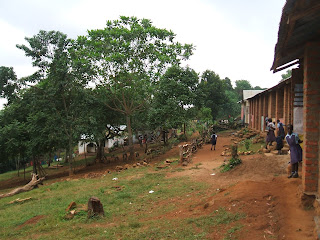As far as I can ascertain the 54 populated islands of Ssese have between them:
18 government aided schools
1 privately owned school
3 community schools
Enrolment stands at 3,867 pupils (1,764 girls and 2,103 boys)
Pupil/teacher ratio is at 37:1
There are 3 secondary schools with an enrolment of 572
There are 2 tertiary institutions
The four schools we have any form of association with are all in Kalangala Town.
St Dunstan's Secondary School is where our "Pigs for Prosperity" project is based.
This shows the school grounds
Mum and Piglets - "Pigs for Prosperity" Project
During our July 2012 Trip
Josh (from Ross-on-Wye), Chris (from Yorkshire), Me, Jacky (from Milton Keynes), Bethany (from Ross-on-Wye), David Reiner (a Canadian who lives on the island), Sarah (from Hereford), Sue (from Ross-on-Wye), Isaac (the vet who looks after the pigs), Grace (head of the school)
Sserwanga Lwanga Memorial Secondary School is the school attended by Monica Kalungi, the pupil sponsored by The Community Church Wrexham.
The front of one of the school classroom blocks
Pupils at the recent funeral of one of their colleagues
Officially opened by the Ugandan President
Kibanga Church of Uganda State Primary School is one of the school we visit when on the island. It is situated on Main Road not far from Water World. Although spelt Kibanga the word is pronounced "Chibanga".
Whereas in UK schools computers have been the norm for many years this is not so in most Ugandan schools. Here at Kibanga Primary the school secretary is lucky enough to have a typewriter. Most schools have to hand write everything.
We arrive on an inter-school sports day so there aren't many uniforms around
Sue handing over welcome resources to David, the head teacher
Schools often use the sides of their buildings to get important messages over in Luganda....
....and English!
This notice, on one of the walls facing Main Road, may shock us here in the UK, particularly considering this is a primary school. However in Uganda there is no pussyfooting about when it comes to getting the message over! From a very early age children are taught facts necessary for them to live safely. There is a very high incidence of AIDS on the island and you must also realise that children stay at primary school until they are about 14 years old.
Bridge of Hope Infants and Primary Community School is the school that John and Sue first visited about 8 years ago. At that time there were only three classrooms built by school director Lawrence Lweera. Now, thanks to funding from the UK, the school caters from Nursery through to Primary 7 (14 years old) and has two dormitories for orphans and children who can't travel daily, a kitchen and latrines. They are also in the process of building a new nursery block.
Where there is little money it is used on education and food - not elaborate school signs
A reminder that all primary classes are taught solely in English. This is because English is the country's official language - the language not only of education but of form-filling, official notices, banking, commerce, business and tourism. It is essential that the pupils become bilingual to ensure decent career prospects. In the infants classes children are taught in Luganda but guided towards English ready for the transition to primary.
We are welcomed in song by some of the pupils of Bridge of Hope School
Showing the school playing field and some of the classrooms
You can see that the classrooms don't have windows or doors
In July we taught the children about the Queen's Jubilee and they made crowns
This is typical of what the children normally have for dinner (probably the only food they'll eat all day). The banana-looking vegetables are the matooke (you saw these in the market place in the previous post). This is served with beans and groundnut gravy! We got forks. The children eat with their right hands. That is because they use their left hands for wiping their bottoms when they go to the toilet. It is vital if you are eating with your hands in most third world countries that you only use your right hand. They find the use of the left hand for food disgusting!
The foundations for the new nursery block - with one of its future pupils!
When we visited in January 2013 we presented two complete football kits from Brierley Cubs Junior Football Club near Barnsley, Yorkshire, where my son James coaches. Here you can see the school director Lawrence Lweera, Sue Gasston and me with some of the pupils wearing the football tops.





















Mike Mike Mike...i came across this blog when i was trying to find out more on the education of children in Ssesse. its amusing though you used the ugandan way of reporting, everything is bare blunt and a little bit arrongant.
ReplyDeleteotherwise thanks for the great work.